It has been a few years since I have tested and reviewed a laptop. Technology has progressed in the meantime, and systems are dramatically more powerful than they were four years ago, although GPUs have improved more than CPUs by most measures. I recently had the opportunity to test out the new Dell Precision 5480. This is Dell’s highest end, small form factor laptop. It is a 14″ system, packed with a 14-Core 13900H CPU, 64GB of DDR5 memory, and an RTX 3000 Ada generation GPU. There are lots of laptop options out there with a 13900H CPU, with 6 hyperthreaded performance cores and 8 efficiency cores, for a total of 20 processing threads, but not very many of those are in a small 14″ frame. And the RTX 3000 Ada is even harder to come by. With 4608 CUDA cores, 8GB of GDDR6 memory, and nearly 20 TeraFlops of processing power, the RTX 3000 GPU is the physical equivalent of the GeForce 4070 Mobile, but with professional level drivers. So this little laptop system packs a punch.
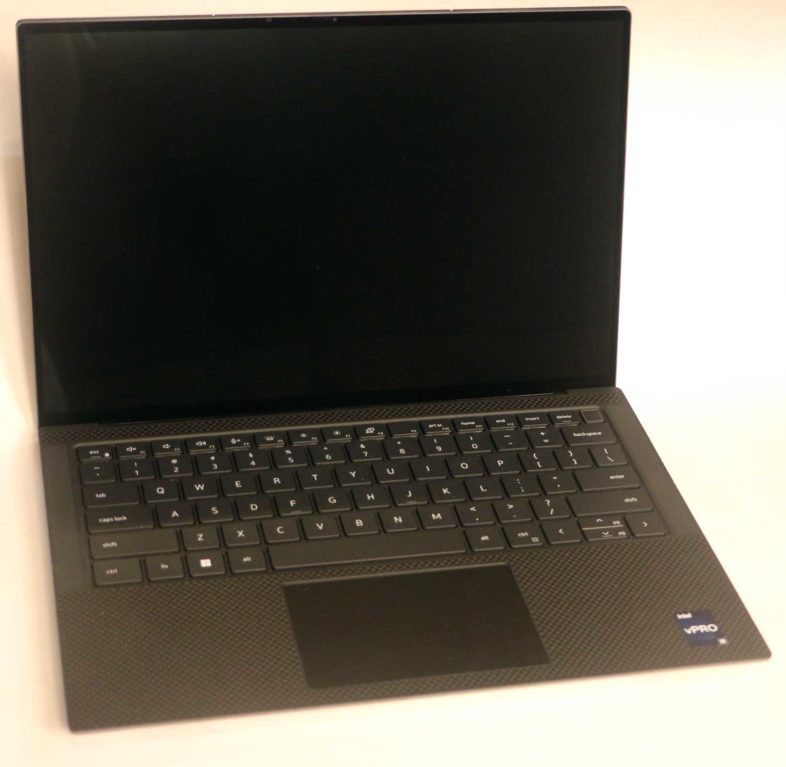 The Display
The Display
Now there is no getting around the fact that 14″ is a very small screen. And I like huge screens, so even an 18″ laptop screen would seem small to me. But I intend for much of my time using any laptop to be spent with it connected to a larger display on my desk in the office or at home. For times when I am using it on the move, or at the kitchen table for some reason, this 2560×1600 WLED screen is a good resolution for the 14″ size, and can be set to 100% scale by eagle eyed users who covet screen real estate, but most people will have a good experience at 150%. It is advertised as supporting 500nits, which can be helpful when using it outdoors, but it is a glossy screen. Windows reports that the display supports HDR video streaming, but no ‘Use HDR” for the UI. I am still trying to figure out the logic behind Microsoft’s support for HDR monitoring. The screen also supports blue light filtering at a hardware level, to reduce eye-strain, which should be better than Window’s ‘Night light’ software solution. It is also a touch screen, which can be a useful feature on occasion.
The Internals
I am always interested in fitting the maximum amount of useful computing power into the smallest possible package. I remember testing the PNY Prevail Pro as the smallest VR capable system at 15 inches back in the day. Beyond that, I still have my 13″ Sony Z1 with Quad Core 3Ghz CPU, GeForce 330M, and dual SSDs, which could run Premiere Pro CS5 with full CUDA acceleration in a 3lbs package back in 2010. (This system is actually very similar to that one, size and weight wise, but of course far more powerful.) Any system smaller than 15 inches with a discrete GPU is usually hard to come by, which is why my ZBook X2 with Quadro GPU and 14″ 10-bit display was so unique. But that system is 5 years old, with no direct replacement available. So I was very excited to see that Dell was stepping up to the plate with a powerful 14″ professional workstation, in a 3.3lbs package under 3/4 inch thick. And with a 13th gen Intel CPU supporting 20 threads, paired with a new Ada based RTX GPU with 20TeraFLOPs, it is not lacking in power.
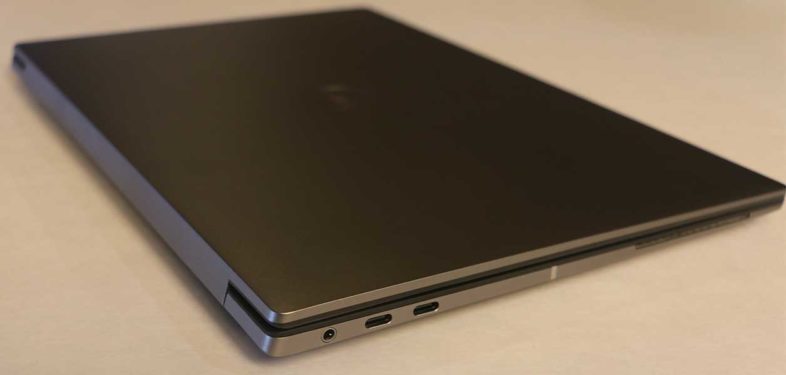
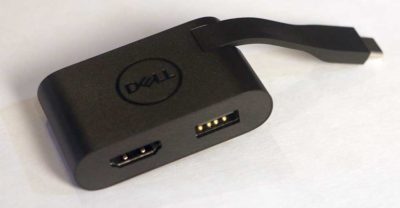 The machine has four Thunderbolt 4 ports, which are all power delivery capable, plus an analog audio jack and a MicroSD reader. It comes with a small USB-C device that offers a USB-A port and an HDMI 2.0 output. The keyboard seems solid, with half-size up and down arrows, and a fingerprint enabled power button in the upper right corner, which will be natural for Mac users.
The machine has four Thunderbolt 4 ports, which are all power delivery capable, plus an analog audio jack and a MicroSD reader. It comes with a small USB-C device that offers a USB-A port and an HDMI 2.0 output. The keyboard seems solid, with half-size up and down arrows, and a fingerprint enabled power button in the upper right corner, which will be natural for Mac users. 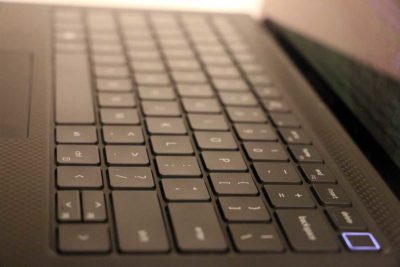 The touchpad in my initial demo unit had a sticking issue with the click mechanism, which I thought might be due to haptics or some other such feature, or just my own trouble in adjusting to different touchpads. But it turned out to have just been a defect, and once replaced, the touchpad worked great. This process did highlight to me just how important a touchpad is on a small laptop, even as a mouse user. Anytime I am using the laptop on the go (the point of a small laptop), it is the main pointing device, so I use it far more than I originally recognized.
The touchpad in my initial demo unit had a sticking issue with the click mechanism, which I thought might be due to haptics or some other such feature, or just my own trouble in adjusting to different touchpads. But it turned out to have just been a defect, and once replaced, the touchpad worked great. This process did highlight to me just how important a touchpad is on a small laptop, even as a mouse user. Anytime I am using the laptop on the go (the point of a small laptop), it is the main pointing device, so I use it far more than I originally recognized.
 The system comes with a USB-C based power supply, rated for 130 watts, as well as the previously mentioned adapter for HDMI and USB-A ports. It comes packaged in a molded cardboard container, inside a folded cardboard packing box, for good product protection, but more eco-friendly than the older Styrofoam based packaging.
The system comes with a USB-C based power supply, rated for 130 watts, as well as the previously mentioned adapter for HDMI and USB-A ports. It comes packaged in a molded cardboard container, inside a folded cardboard packing box, for good product protection, but more eco-friendly than the older Styrofoam based packaging.
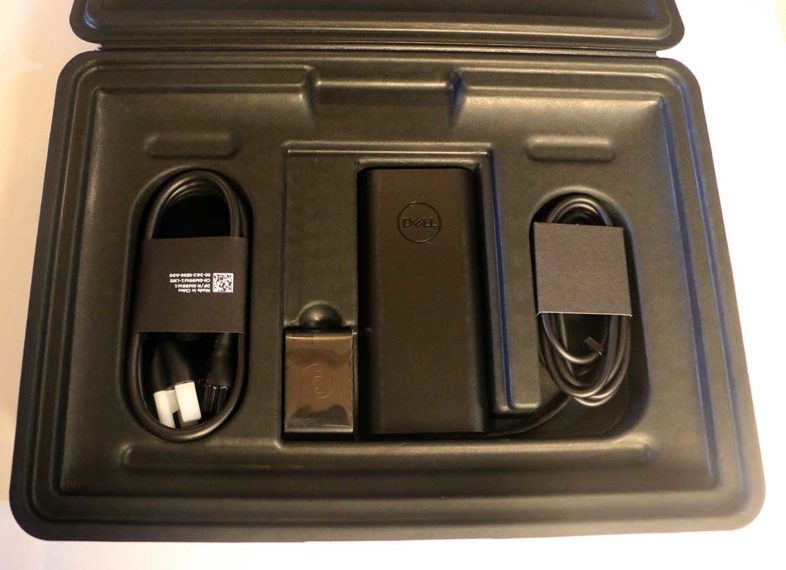
Of course the biggest drawback of small laptops is small screen size, but you can also treat it like a portable computer, that you use in your office, with a full set of peripherals, and then when at home, you plug in your monitor and accessories there, and pick up exactly where you left off. Now with virtual desktops, you can get a similar experience by working in the cloud, on various systems at different locations, but that doesn’t allow you full access when you are in transit, or when you are in places with limited internet access. This seems like an ideal system for anyone who needs editing power on the go, and has monitors to plug in to it in their primary work environments. (So they don’t need a larger laptop display on the unit itself.)
Battery Life
Now admittedly this specific configuration of this model should be expected to have the worst possible battery life (most powerful CPU and GPU available, with high res screen) but it is still an important factor. I used this system when I attended the Adobe MAX conference, and I did not bring the charger with me during the day. The only time I regretted that is when I accidently left Photoshop running in the background for a few hours, and activating the GPU does make a difference. But otherwise I was able to do basic tasks all day long with no issue. And I usually get about 2 hours of usage when playing a 3D game before I have to plug in. So they have done a great job saving power when it is not needed, but when you are doing power hungry performance based tasks, it will drain the battery, which is to be expected. But when just doing simple browser based tasks, I was able to use it all day, while bouncing between different conference sessions, without issue.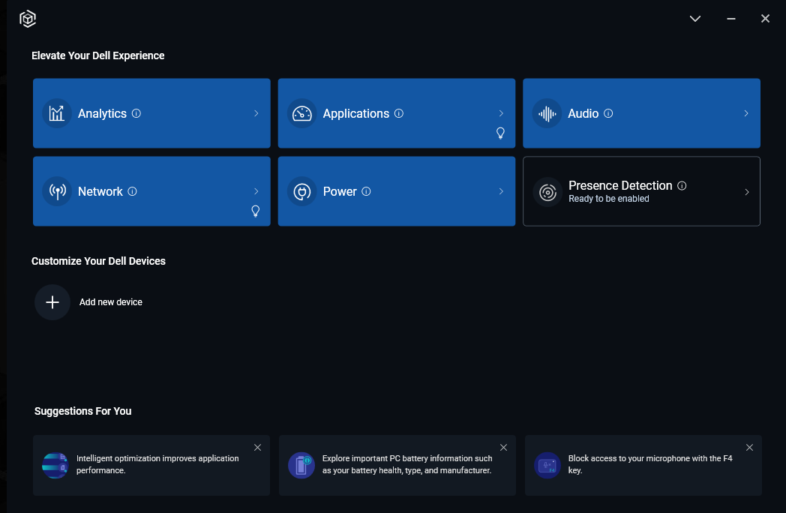
Software
The unit comes with Windows 11 Pro installed. Even after 18 months, I still have not “adapted” to Microsoft’s newest OS, and I prefer Windows 10. But, based on my performance tests, the thread director in Windows 11, which is aware of the difference between the performance cores and the efficiency cores on Intel’s newest chips, does make a difference. (Windows 10 assigns hard tasks to the efficiency cores, and it takes longer to finish them, decreasing overall performance.) One way around this is to disable the e-Cores in the BIOS and stick with Windows 10, but especially on a laptop, that negates much of the power efficiency of the newer designs. So you are pretty stuck with Windows 11 on these newer systems. But besides that, it comes with very little bloatware pre-installed, just drivers and utilities for the various hardware devices, and some Dell performance and configuration optimization tools.
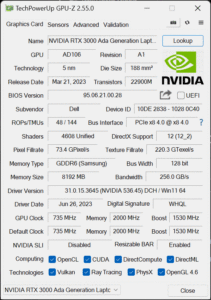 The Graphics Processor
The Graphics Processor
The RTX 3000 GPU is the physical equivalent of the GeForce 4070 Mobile, with 4608 CUDA cores, 8GB of GDDR6 memory, and nearly 20 TeraFlops of processing power. It benchmarks with about 25% of the performance of my giant GeForce 4090 desktop card, which is to be expected based on the paper specs. This is actually fine in most cases, since I am rarely harnessing the full power of that GPU when doing regular editing tasks. 20 Teraflops is twice the performance of the top end GeForce 2080/RTX5000 from 2 generations ago, and now available in a 14″ laptop.
I also tested it with a number of external displays, which would be key for professional use of a model this size, up to and including the Dell UltraSharp UP3218K monitor, which was supported in its full 8K at 60fps resolution with the use of two USB-C to DisplayPort cables. The last HP mobile workstation I tested required a docking station for full support of that display, and my Razer is limited to 30fps unless I use an external GPU. So it is good to see that Dell fully supports their own display range on their system, while I recognize that is really a function of the GPU and supported output ports. But nonetheless, you can use this system with an 8K monitor if you so desire.
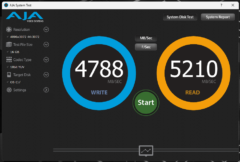 Storage
Storage
The hard drive reports 4.5GB/s Write, and 4.8GB/s read in AJA System Test, which isn’t the fastest PCIe 4.0 speed, but more than enough for 99% of power users. Dell offers SSDs in sizes from 256GB to 4TB, with self encrypting models at 512GB and 1TB for users with those requirements.
Performance
CPUs are much harder to compare on paper, which is why tools like Maxon’s CineBench are so valuable. Blender also has a benchmarking tool for comparing system performance. And performance is always a relative measure, since we are comparing a specific system (this one) to other potential options. Usually reviewers compare systems to others that are very similar, but in this case I took a different approach for two reasons. First I don’t have similar current options to compare to, and second, there is value in comparing what you are sacrificing when you scale down to a small laptop. Which tasks can you do effectively on a mobile system, and which are worth waiting until you are in front of (or remoting into) a powerful desktop workstation?
The 13900H, with 6 performance cores and 8 efficiency cores, has 20 threads available to the OS. My desktop with a 12700K CPU also has 20 threads, coming from 8 performance cores and 4 efficiency cores. In most synthetic render tests this little laptop has about 70% of the CPU processing power of my consumer desktop tower.
In real world tests, exporting cinema quality files out of Premiere Pro, my tests were…frustratingly inconsistent. This appears to result from a combination of both Intel’s new power saving technology, and Adobe’s software optimizations. I ran my entire suite of standard test exports multiple times, and got widely varying results. I then re-ran them repeatedly on my 12700K based desktop, and also got less consistent results than I recall in the past. But most of the time, I test repeatedly with slightly different settings, I don’t repeat the exact same test a number of times. This has really shifted my view on quantifying performance in Premiere Pro. The best test would be a live playback test, and potentially a latency test for how long after you press space bar the playback begins. But due to the playback optimizations within the program, this is no longer a good way to compare different systems. Puget Systems, who do great work in benchmarking, detail the challenges of quantifying performance in Premiere Pro in this great article that dives even deeper into it than I have. Regardless of those limitations, here are the raw numbers from my Media Encoder benchmarks, for you to evaluate, compared to my other systems.
Suffice it to say that this machine can edit and play back nearly any sequence, due to Premiere’s optimizations, and can export high quality output files with decent performance, but longer renders, and Red source footage, might be best to render on your desktop workstation. This is totally reasonable for a portable laptop; no one should expect a 14″ notebook to replace server level hardware. But it can accomplish most editing tasks with ease.
Conclusion
One surprising thing I learned from testing this system, is that I personally no longer require such a small system. It was great to have something so lightweight when I was traveling, but I so rarely travel now, and when I do, I rarely need full performance at my fingertips. I used to go to and from the office daily, and to other studios or on-set filming locations on a weekly or monthly basis. And I needed the performance to show off my work in progress at those locations. Now I usually only go from my kitchen to my home office/editing room, so my needs have changed, and it has taken a while for my perception to catch up. (Something similar happened with the move away from dual socket workstations over the last few years.) That will make it harder to find the ideal system for me since there are so many more options available once I relax my size and performance requirements. But if you do need a powerful 14″ system, this is probably the best one you are going to find.



